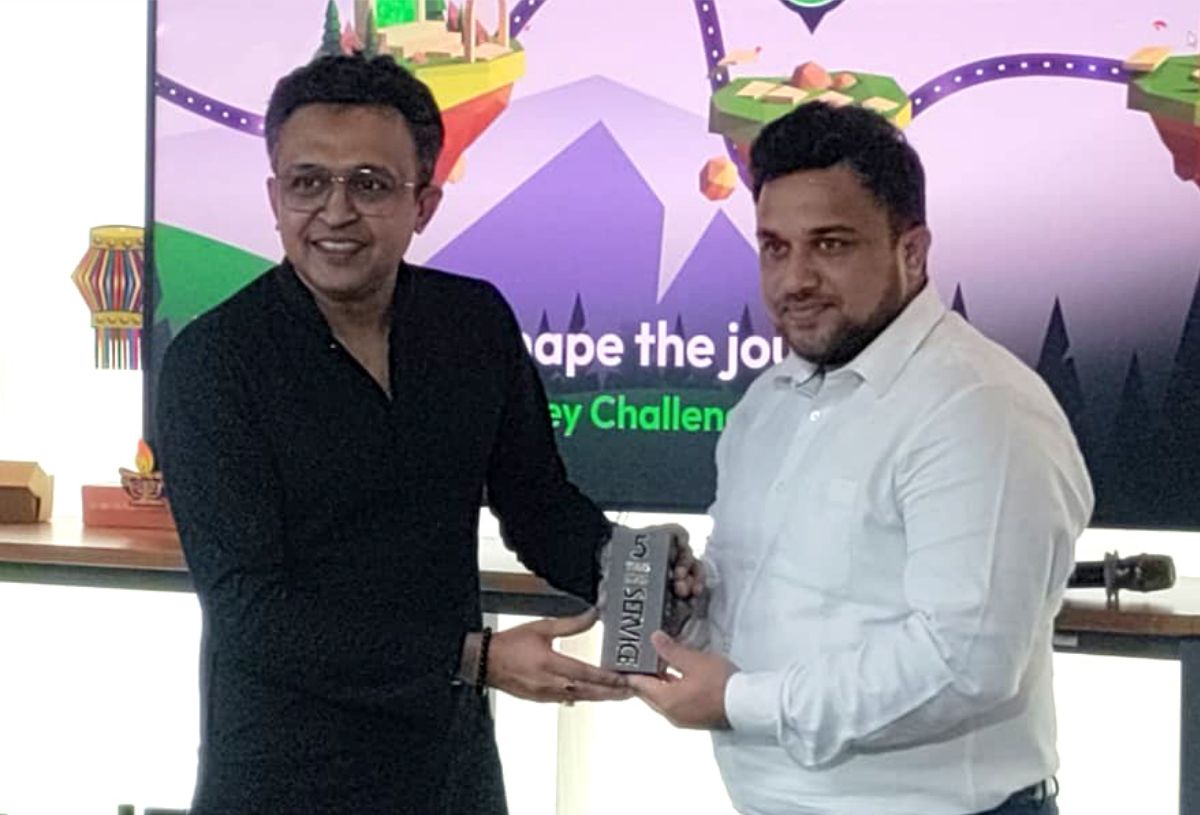Key Employee Recognition Software Features for Large Companies

Updated on
March 18, 2025
18
March
2025
Employee recognition software is a powerful tool to help your organisation retain top talent and increase productivity and morale.
These platforms offer a range of features designed to streamline the recognition process, foster a positive workplace culture, and boost employee engagement. From real-time feedback and custom awards to analytics and integration capabilities, employee recognition software is transforming how companies celebrate their workforce’s achievements.
At O.C. Tanner, we work with global organisations to deliver software and services that improve workplace culture through meaningful employee recognition experiences. Based on our experience with thousands of companies, these are the key features you should look for when evaluating employee recognition software for your organisation.
See how the world’s top organisations use O.C. Tanner’s Culture Cloud employee recognition software to create thriving workplace cultures.
1. Highly secure, cloud-based recognition solution
Large companies need a flexible, long-term, cloud-based solution that can be implemented globally throughout the organisation. This includes features like Single Sign On (SSO) access so employees don’t have to wade through different integrations or applications. Verified security protocols are also essential for enterprise-level solutions.
Security is not an optional feature. Employee appreciation platforms must meet high standards such as:
- EU-US Privacy Shield, a framework for transatlantic exchanges of personal data between the European Union and the United States;
- SOC 2 and SOC 3 reporting to attest that controls are in place to safeguard data;
- and General Data Protection Regulation (GDPR) compliance to meet Europe’s standards for data privacy and security.

Culture Cloud, O.C. Tanner’s comprehensive employee recognition platform, is the industry’s first provider to have SOC 3 status for security, privacy, and confidentiality.
2. Leader and peer-to-peer recognition tools
Recognition software with flexible and customisable features for both leaders and peers is essential. Our research shows that employee recognition software is most effective when everyone across the organisation has access to give and receive recognition, regardless of their title or location.

Leader and peer recognition tools should come in many forms:
- Recognition eCards: Notes of thanks, with or without a monetary point reward.
- Award nominations: Formal recognition with an approval process and a monetary component.
- Recognition points: Monetary rewards shared with awards or eCards, accrued over time.
- Reward cards: Physical recognition cards, including a code for recognition points.
- Recognition Coach: In the moment micro-coaching, powered by AI, for better recognition messages.
Utilising AI can make us not just better writers, but better recognisers. Learn about O.C. Tanner’s AI Recognition Coach and the growing suite of AI-powered tools available on our Culture Cloud platform.
Each recognition moment shared between leaders and peers can be showcased on your program’s social feed, where coworkers can read, like, and comment on recently given recognition.
3. Career anniversary recognition experiences
Enterprises should choose recognition software that can integrate career anniversary awards (also called years of service awards). But HR leaders should look for software that does more than merely deliver an award on a specific date to mark a special day.
Employee recognition programs, like the Anniversaries solution from O.C. Tanner, can automatically collect team comments and photos to create a memorable digital and printed Yearbook as a keepsake of the achievement.
A superior employee recognition platform should allow you to combine meaningful symbolic awards with the opportunity to choose a personal item from a catalogue of gifts with enduring value. The software should also facilitate certificates, presentation tips, alerts, and reminders for upcoming anniversaries.

4. Global rewards and fulfillment
Recognition programs should offer not only a wide selection of merchandise and gift cards, but also global fulfillment. This is important to large enterprises that operate in many international locations.
In addition to global fulfillment, a great recognition program will offer rewards that differ by country and location for the best selection of awards across cultures. A good reward variety will include brand-name merchandise, tech gadgets, adventures, concerts, sporting events, trips, gift cards, charitable giving, and more.

O.C. Tanner’s Global Award Store, accessed through Culture Cloud, offers reward options for a diverse, global workforce.
5. Native mobile app and offline solutions
Recognition software that includes a native mobile application makes it easier for employees to recognise in the moment. In fact, mobile users give recognition 98% more than their non-mobile counterparts.
However, it’s important to distinguish a native mobile app from a mobile-responsive website. Although any recognition site’s content can be optimized for a mobile device, a fully optimized mobile app for iOS or Android can deliver a richer, more enjoyable user experience.

Mobile apps for employee recognition can also make it easier for offline employees, or workers not behind a computer, to access your employee recognition tools and share appreciation regularly.
6. Configurable recognition workflows and rules
It’s always fun to start a new contest to get a team motivated. But, at a large organisation, the number of independently run initiatives, contests, goals, and projects can be difficult to manage.
A leading employee recognition solution will be able to bring all these disparate programs to a single platform, from sales contests and security training to book clubs and product launches. This will make it easier to track and budget for each ongoing activity.

O.C. Tanner’s Culture Cloud offers Initiatives, a workspace to build and delegate multiple recognition projects to teams, leaders, and business units.
7. Pre-built app integrations and open APIs
Our Global Culture Report research found the best way to ensure maximum use of an employee recognition program is by embedding the recognition tools inside the technology that employees already use, like email, browsers, and HRIS software.
When browsing various recognition software, ensure that it offers pre-built and custom integrations to bring recognition into the flow of work for your employees.

That way, a team member can more easily share appreciation with an eCard or award without any extra effort. The more places employees can access recognition tools, the greater the chances that recognition will happen frequently.
8. Robust analytics, dashboards, and insights
Reporting and analytics are critical for HR executive teams to understand how a new employee recognition platform is performing across the organisation.
Look for a full reporting suite that includes information on:
- Real-time and historical recognition activity (given, received, redeemed)
- Team reporting for leaders (recent recognition, downline reporting
- Taxing and invoicing
- Recognition pulse surveys (a benchmark for recognition impact)
- Budget management and usage
Beyond standard usage and budget reporting, a leading recognition solution will also provide you with AI-powered insights to drive program impact. Tools like O.C. Tanner’s Culture Intelligence, available on Culture Cloud, can give you a deeper look at employee sentiment, intent to leave, and other important recognition outcomes.
Our research shows a statistically significant relationship between the amount of recognition people receive and how likely they are to leave. Your employee recognition reporting tools should include insights into the number of employees at risk of leaving in relation to the amount of recognition they’ve received. This allows you to recognise people before they feel critically under-appreciated and reduce the costs of turnover.

O.C. Tanner’s Culture Cloud includes the Flight Risk Dashboard—a clear visualization of the recognition and retention connection.
9. Detailed budget management and tracking
Recognition platforms are only as good as your ability to manage them—and that includes managing the budget.
An effective rewards program is flexible and configurable. For example, does the software allow you to choose whether to be billed when points are awarded vs. when points are redeemed? Depending on how your organisation allocates its budget, you may find one of these options more appropriate.
It’s also important to ensure it offers the ability to set budgets by location, business unit, or based on eligibility. You’ll want the option to set how often budgets are refreshed and also the ability to manage taxes in various locations.
Finally, you’ll want robust reporting that allows you to track your budget usage and make adjustments accordingly.
10. Backed by industry research and best practices
Every feature in an employee recognition software offering should be informed and shaped by recognition industry research, insights, and best practices. This ensures the software remains relevant and effective over time.
When new recognition trends or changes emerge, a recognition partner with an in-house research team can quickly share insights, adapt the software, and create actionable items for your recognition strategy. This will ensure your recognition software provides the greatest return on your investment, both monetarily and culturally.

The O.C. Tanner Institute conducts ongoing research on the trends, statistics, and perceptions that shape employee recognition and workplace cultures around the world. Read the most recent insights from our Global Culture Report.
Making your employee recognition software decision
Choosing an employee recognition software solution that will keep thousands of employees engaged and doing great work is well worth your effort, time, and research.
As you consider the employee recognition software advice in this article, remember that the right employee recognition platform can be different for every organisation. But for most enterprises, the ten employee recognition software features listed above will help you make a solid choice.
As you make your final decision, you may also want to review our full employee recognition program guide to make sure you know what a successful program looks like, and other essential items to consider when investing in recognition program software.
If you’d like to talk to the employee recognition experts at O.C. Tanner about how we can help craft a solution for you, please reach out to us.



